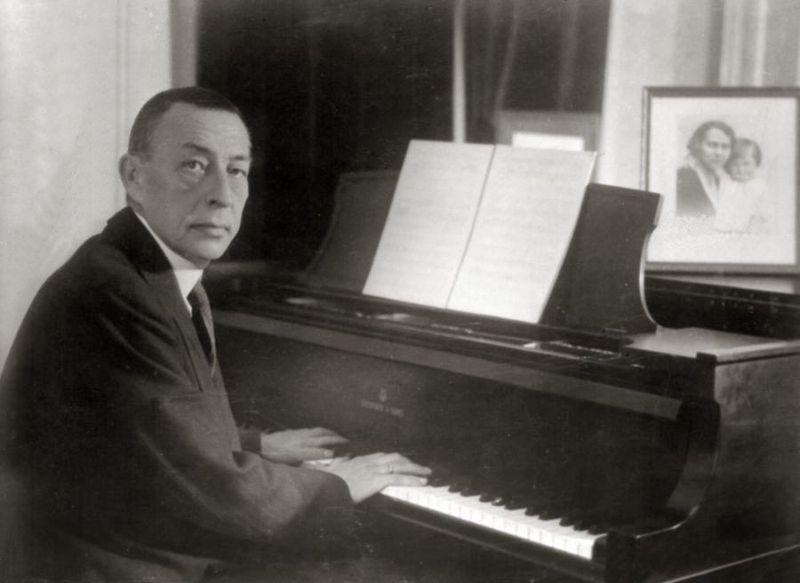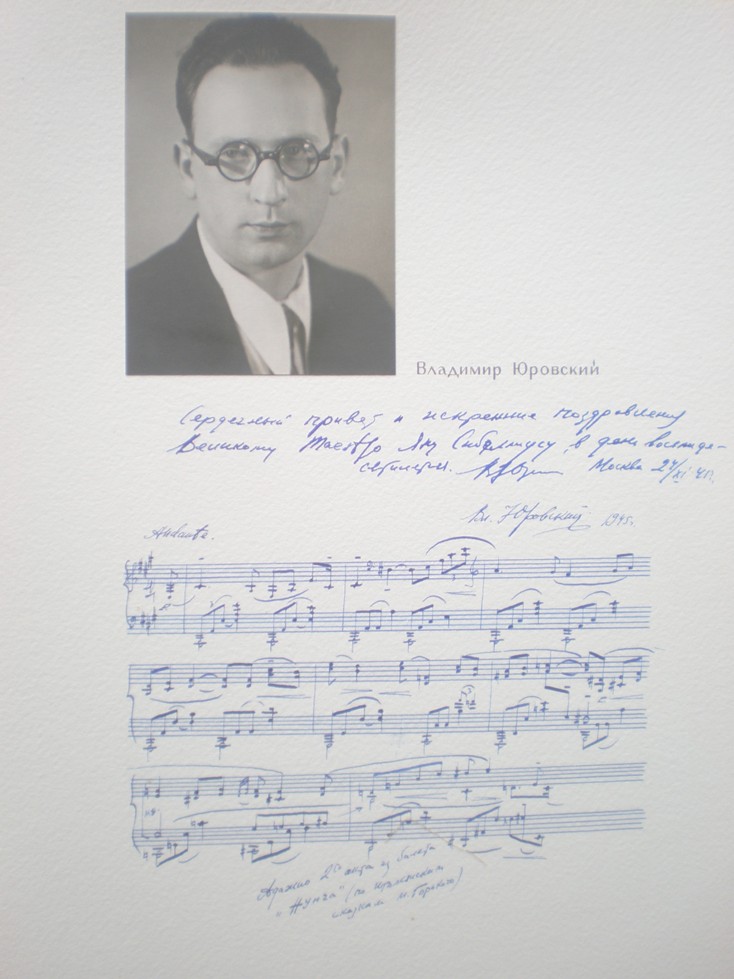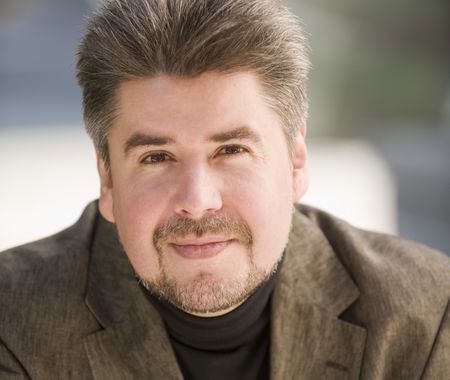Grivnov, LPO, Jurowski, RFH | reviews, news & interviews
Grivnov, LPO, Jurowski, RFH
Grivnov, LPO, Jurowski, RFH
Rachmaninov's dark heart encapsulated in the London Philharmonic's festival finale

Deep pain and sadness expressed through intense creative discipline aren’t qualities noted often enough in the music of Sergey Rachmaninov. Yet they’ve been consistently underlined, with rigour to match, in Vladimir Jurowski’s season-long “Inside Out” festival with his London Philharmonic Orchestra playing at a consistent white heat.
Few Jurowski programmes, even with Rachmaninov at their heart, are penny-plain overture-concerto-symphony formats, and this was no exception. In a first half of spellbinding orchestral transcriptions, he managed to pay two further homages. One was to Yury Butsko, of the back-to-folk-roots generation which also included Shchedrin and Sviridov; Butsko died three days before the concert. His arrangements of four early piano pieces - one solo, three four-hand – began with Rachmaninov’s homage to the “Slava” folk song most famously treated in the Coronation Scene of Boris Godunov; Rachmaninov manages to outdo former celebrants Musorgsky, Rimsky-Korsakov and Tchaikovsky by throwing every harmony and style at it he can think of.
 At the other end of the sequence, there was orthodox chant and an ostinato bell-song in the “Easter” movement of the brilliant First Suite for piano duet which, as Jurowski observed in a pre-performance talk valiantly conducted with a heavy cold, is a striking progenitor of Minimalism. (My own observation is that if you play the opening of the "Alarm Bells" movement in the Rachmaninov work which Jurowski regards as his richest, the “Choral Symphony” The Bells, an unwitting listener might attribute it to John Adams). Butsko’s arrangements, with ample percussion and piano, sounded closer to Stokowski’s outlandish, often rough orchestration of Musorgsky’s Pictures at an Exhibition than to Ravel’s.
At the other end of the sequence, there was orthodox chant and an ostinato bell-song in the “Easter” movement of the brilliant First Suite for piano duet which, as Jurowski observed in a pre-performance talk valiantly conducted with a heavy cold, is a striking progenitor of Minimalism. (My own observation is that if you play the opening of the "Alarm Bells" movement in the Rachmaninov work which Jurowski regards as his richest, the “Choral Symphony” The Bells, an unwitting listener might attribute it to John Adams). Butsko’s arrangements, with ample percussion and piano, sounded closer to Stokowski’s outlandish, often rough orchestration of Musorgsky’s Pictures at an Exhibition than to Ravel’s.
The other homage was to Jurowski’s grandfather, also Vladimir, a well-respected Soviet-era composer whose 100th anniversary we were marking; strange to think he was born in the year Scriabin died (pictured above: a homage from Jurowski the composer to Sibelius on his 80th birthday, unearthed during the author's research at Sibelius's house-museum, Ainola). His arrangements of 10 Rachmaninov songs – a sphere in which it becomes ever more obvious the composer excelled as much as in any other – were made for one of the two great Russian tenors of the mid-20th century, Ivan Kozlovsky, a less sweet voice than his rival Sergey Lemeshev but a perfect inflector of his native language.
This made Vsevolod Grivnov (pictured below by Kirsten Loken Anstey) the ideal choice for the sequence. Standing without a score, conducting himself with his right hand, Grivnov was perfectly able to scale down his heroic tenor to poetic slivers of sound in fugitive visions like “The little island” and “Sleep” – for me one of the greatest songs of all time, up there with Schubert and Mahler in the amazing harmonies and hypnotic effect Rachmaninov uses to conjure Sologub’s transcendent verses.
 The elder Jurowski's orchestrations are mostly subtle, paying Rachmaninov clear homage in the disconsolate violas which sympathise with the outsider at the Russian Orthodox service in “Christ is risen!” and reduced to chamber proportions, with the grandson further cutting back the number of strings, in the pessimistic musical realization of Sonya’s “We shall rest!” speech at the end of Chekhov’s Uncle Vanya (wouldn’t it be good to get a number of contemporary Russian composers to give their responses to this ambiguous curtain?). Ten songs might seem rather a lot, but many finish before you want them to, and despite persistent applause between numbers, Grivnov and Jurowski held the tearful alternation of bitter and sweet to absolute perfection, a real marriage of voice and instruments.
The elder Jurowski's orchestrations are mostly subtle, paying Rachmaninov clear homage in the disconsolate violas which sympathise with the outsider at the Russian Orthodox service in “Christ is risen!” and reduced to chamber proportions, with the grandson further cutting back the number of strings, in the pessimistic musical realization of Sonya’s “We shall rest!” speech at the end of Chekhov’s Uncle Vanya (wouldn’t it be good to get a number of contemporary Russian composers to give their responses to this ambiguous curtain?). Ten songs might seem rather a lot, but many finish before you want them to, and despite persistent applause between numbers, Grivnov and Jurowski held the tearful alternation of bitter and sweet to absolute perfection, a real marriage of voice and instruments.
Jurowski had told us that he didn’t begin to understand the Third Symphony until he heard the composer’s own interpretation – one of only three recordings of Rachmaninov as conductor – and then only by listening again and again. His own reading had equal flexibility, but a very different approach in emphasising the depths and making time stand still. Easier to do by ignoring, like the composer-conductor, the first movement’s exposition repeat; the drama surged achingly forward, the big melodies unfolded mesmerically with necessary portamenti, the slides between notes, but no hint of Hollywood splurge. Rachmaninov was writing for the famous Philadelphia strings of the 1930s, but he exposes violins rather than indulges them in a surprisingly lean work where no player can get away with a lazy phrase.
The LPO sound was as magnificent in fullness as it was haunting in the twilight zones, with excellent work from principal horn John Ryan, oboist Ian Hardwick and cor anglais player Sue Böhling. Jurowski even made a virtue out of a certain irresolute quality in the structure of Rachmaninov’s finale, alternately ferocious and lost, with a hair-raising coda based on the composer’s obsession with the Dies Irae or Latin “day of wrath” chant full of demonic associations. Usually the symphony ends in a glittering cannonade; this was a dance of death until the end, razor-sharp in precision but still overwhelmingly exciting in its impact. Rachmaninov as one of the 20th century's truly great and serious composers? Unquestionably.
rating
Share this article
The future of Arts Journalism
You can stop theartsdesk.com closing!
We urgently need financing to survive. Our fundraising drive has thus far raised £49,000 but we need to reach £100,000 or we will be forced to close. Please contribute here: https://gofund.me/c3f6033d
And if you can forward this information to anyone who might assist, we’d be grateful.

Subscribe to theartsdesk.com
Thank you for continuing to read our work on theartsdesk.com. For unlimited access to every article in its entirety, including our archive of more than 15,000 pieces, we're asking for £5 per month or £40 per year. We feel it's a very good deal, and hope you do too.
To take a subscription now simply click here.
And if you're looking for that extra gift for a friend or family member, why not treat them to a theartsdesk.com gift subscription?
more Classical music
 theartsdesk at the Lahti Sibelius Festival - early epics by the Finnish master in context
Finnish heroes meet their Austro-German counterparts in breathtaking interpretations
theartsdesk at the Lahti Sibelius Festival - early epics by the Finnish master in context
Finnish heroes meet their Austro-German counterparts in breathtaking interpretations
 Classical CDs: Sleigh rides, pancakes and cigars
Two big boxes, plus new music for brass and a pair of clarinet concertos
Classical CDs: Sleigh rides, pancakes and cigars
Two big boxes, plus new music for brass and a pair of clarinet concertos
 Waley-Cohen, Manchester Camerata, Pether, Whitworth Art Gallery, Manchester review - premiere of no ordinary violin concerto
Images of maternal care inspired by Hepworth and played in a gallery setting
Waley-Cohen, Manchester Camerata, Pether, Whitworth Art Gallery, Manchester review - premiere of no ordinary violin concerto
Images of maternal care inspired by Hepworth and played in a gallery setting
 BBC Proms: Barruk, Norwegian Chamber Orchestra, Kuusisto review - vague incantations, precise laments
First-half mix of Sámi songs and string things falters, but Shostakovich scours the soul
BBC Proms: Barruk, Norwegian Chamber Orchestra, Kuusisto review - vague incantations, precise laments
First-half mix of Sámi songs and string things falters, but Shostakovich scours the soul
 BBC Proms: Alexander’s Feast, Irish Baroque Orchestra, Whelan review - rapturous Handel fills the space
Pure joy, with a touch of introspection, from a great ensemble and three superb soloists
BBC Proms: Alexander’s Feast, Irish Baroque Orchestra, Whelan review - rapturous Handel fills the space
Pure joy, with a touch of introspection, from a great ensemble and three superb soloists
 BBC Proms: Moore, LSO, Bancroft review - the freshness of morning wind and brass
English concert band music...and an outlier
BBC Proms: Moore, LSO, Bancroft review - the freshness of morning wind and brass
English concert band music...and an outlier
 Willis-Sørensen, Ukrainian Freedom Orchestra, Wilson, Cadogan Hall review - romantic resilience
Passion, and polish, from Kyiv's musical warriors
Willis-Sørensen, Ukrainian Freedom Orchestra, Wilson, Cadogan Hall review - romantic resilience
Passion, and polish, from Kyiv's musical warriors
 BBC Proms: Faust, Gewandhausorchester Leipzig, Nelsons review - grace, then grandeur
A great fiddler lightens a dense orchestral palette
BBC Proms: Faust, Gewandhausorchester Leipzig, Nelsons review - grace, then grandeur
A great fiddler lightens a dense orchestral palette
 BBC Proms: Jansen, Royal Concertgebouw Orchestra, Mäkelä review - confirming a phenomenon
Second Prom of a great orchestra and chief conductor in waiting never puts a foot wrong
BBC Proms: Jansen, Royal Concertgebouw Orchestra, Mäkelä review - confirming a phenomenon
Second Prom of a great orchestra and chief conductor in waiting never puts a foot wrong
 BBC Proms: Royal Concertgebouw Orchestra, Mäkelä review - defiantly introverted Mahler 5 gives food for thought
Chief Conductor in Waiting has supple, nuanced chemistry with a great orchestra
BBC Proms: Royal Concertgebouw Orchestra, Mäkelä review - defiantly introverted Mahler 5 gives food for thought
Chief Conductor in Waiting has supple, nuanced chemistry with a great orchestra
 Dunedin Consort, Butt / D’Angelo, Muñoz, Edinburgh International Festival 2025 review - tedious Handel, directionless song recital
Ho-hum 'comic' cantata, and a song recital needing more than a beautiful voice
Dunedin Consort, Butt / D’Angelo, Muñoz, Edinburgh International Festival 2025 review - tedious Handel, directionless song recital
Ho-hum 'comic' cantata, and a song recital needing more than a beautiful voice
 Classical CDs: Dungeons, microtones and psychic distress
This year's big anniversary celebrated with a pair of boxes, plus clarinets, pianos and sacred music
Classical CDs: Dungeons, microtones and psychic distress
This year's big anniversary celebrated with a pair of boxes, plus clarinets, pianos and sacred music

Add comment